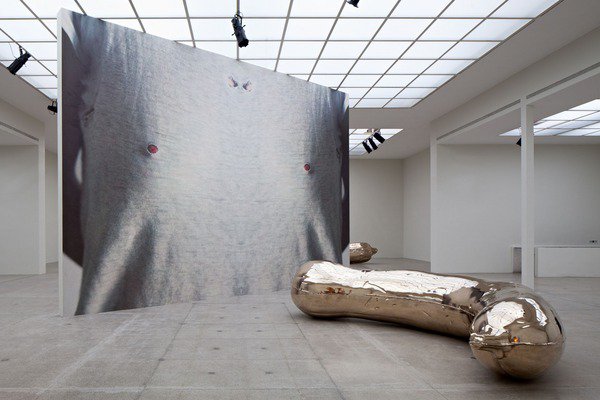Three exhibitions
dal 22/11/2013 al 18/1/2014
Segnalato da
22/11/2013
Three exhibitions
Wiener Secession, Wien
Three parallel exhibitions from three different european artists. Sarah Lucas has developed an unmistakable visual and material language rich in art-historical references and associations. Tobias Pils's large-format, abstract painting develops from questions raised in close connection to the painting process itself. As the protagonist of his own films, Dutch video and performance artist Guido van der Werve makes great physical demands upon himself.

Sarah Lucas: NOB + Gelatin
Sarah Lucas is one of the most outstanding British artists of her generation, who garnered an international reputation under the heading Young British Artists in the 1990s. With the sculptures and objects she makes from readily available materials such as household objects or foodstuffs, as well as her photographic self-portraits, Sarah Lucas has developed an unmistakable visual and material language rich in art-historical references and associations.
The artist reveals and simultaneously undermines sexual stereotypes with the outspoken directness of the sexual innuendo characteristic of her works. In this way Lucas always expresses deep scepticism towards social norms and the gender-specific attribution of roles, albeit with an enigmatic sense of humour.
In the Secession, Sarah Lucas will be presenting new, large-format sculptures: oversized phallic objects made from concrete rest on pressed scrap vehicles, and are reflected on the polished bronze surfaces of two marrow sculptures of surely record-breaking dimensions. In a fragmented, rather androgynous form, the female body is present as a motif on wallpapers the height of the room. Other elements produced on site lend the exhibition added relevance and location.
An artist's book conceived and designed together with Julian Simmons will be published in conjunction for the exhibition; in texts and images it offers insight into the production process behind Sarah Lucas's sculptural works.
Sarah Lucas, born in London in 1962, lives and works in Suffolk, UK.
Tobias Pils: Secession
Tobias Pils's large-format, abstract painting—occasionally laced with representational fragments—develops from questions raised in close connection to the painting process itself. He has produced an extensive new work cycle for his major individual presentation in the gallery. The title of the exhibition is simply Secession. Among other things, the exhibition behind this minimalist announcement takes up historical references relating to the Secession and the zeitgeist in Vienna at the start of the 20th century.
Pils's reference to the Secession is entirely non-judgemental and not limited to formal aspects. In the exhibition this leads to a game with materials, techniques and unusual references, e.g. to underground tunnels and to Adolf Loos, well-known for his criticism of the secession movement.
Ornamental elements and characteristic forms like the motif of the laurel-leaf dome—the Secession's ultimate hallmark—flow as if naturally into the artist's pictorial language. The presentation of the works is conceived as an extension of the exhibition space and characterised by an experimental understanding of painterly mise-en-scène. Long before the actual painting process, Pils conceived a kind of artistic guidance system, which leads the visitors from the foyer of the Secession into the exhibition rooms of the gallery on the basement floor. One component of this staging is the stairwell to the basement floor, which is faced with handmade ceramic tiles, painted with wavering blue lines: here, there are also two round, large-format paintings that direct the visitors' gaze and so guide them into the actual exhibition rooms of the gallery.
A catalogue will be appearing for the exhibition, including numerous illustrations, a foreword by András Pálffy, and texts by Richard Shiff and Roberto Ohrt.
Tobias Pils, born in Linz, Austria, in 1971, lives and works in Vienna.
Guido van der Werve: at war with oneself
As the protagonist of his own films, Dutch video and performance artist Guido van der Werve makes great physical demands upon himself. His works chart approaches to the experience of self and the world by staging an existentialist competition with himself. However, he not only documents the realisation of the conceived events; this documentation is also taken as a starting point from which to condense them into complex narratives about physical endurance, struggling with (one's own) nature, the passage of time, and the uncontrollable dynamics of chance. Van der Werve, who has also completed training as a classical pianist, often anchors his narratives structurally by reference to the biographies of composers such as Rachmaninov or Chopin, as well as using his own musical compositions. In this way he produces works that measure spatial and temporal determinants by means of physical effort, yet also bear witness to a deep melancholy and the need to come to terms with isolation.
In the 56-minute film Nummer veertien, home van der Werve completes a 1,700 km triathlon—seven times the stretch of the Ironman triathlon. Swimming, cycling and running he had covered the distance from Warsaw to Paris to retrace, in the opposite direction, the route that Chopin's heart travelled before being buried.
The filmic narrative's division into three parts not only corresponds to the triathlon but also to the requiem that van der Werve composed himself for this occasion. It is also used as a soundtrack.
Nummer veertien, home is part of the latest group of works by van der Werve, in which his theme is sport alongside classical music. He plans to complete and review this group with his artist's book produced on the occasion of the exhibition in the Secession, Nummer vijftien, at war with oneself. The extensive publication includes textual and pictorial documents, self-reflective pieces and analyses of his works from the last five years.
Guido van der Werve, born in Papendrech, the Netherlands, in 1977, lives and works in Berlin and Finland.
Opening Friday, November 22 at 19
Wiener Secession
Friedrichstrasse 12, Wien
Open hours: from Tuesday to Sunday 10 - 18



